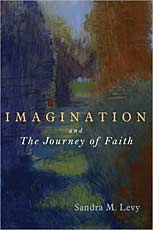Visual Symbol and Story: Meeting God in Paintings and Sculpture
"Robin Jensen makes a strong argument for the power of pictures over words. She says that what we see, sometimes even in passing, becomes what we are, becomes unshakable from memory. I think we can all remember vividly certain images — snapshots, films, journalistic photos — that have become indelibly imprinted on our brains.
"For me it is an image that appeared on the front page of a newspaper during the Gulf War period. The picture showed a line of our troops, kneeling as if in prayer, with gas masks completely covering their faces. They looked something like muzzled dogs, staring into the camera. It was a startling juxtaposition of the horrors of biologic warfare and the posture of prayer. Images can have a searing effect, while words fade from memory.
"Yet while Jensen says that 'words can never adequately describe what we see and know through that process of seeing,' she nevertheless insists that images — even perhaps the most abstract, symbolic works of art — cannot be completely detached from the metaphors and stories of our tradition. As she explains, 'The meaning of pictures depend on the interactivity with the stories and the familiar interpretations of those stories as known to the observers . . and . . finally by the imagination and insight of the viewers themselves.' Again, the engaged viewer thus becomes a co-creator with the artist, responding out of her own tradition and history, using her own imagination to create a story for herself.
"For example, I have just come across a painting by the Dutch artist Jan Vanriet entitled Three Nails. It's a 13 x 8 1/2" watercolor depicting three large, spiky black nails painted on a mostly blood-red background. If you are a product of Western Christian culture, it is a startling image suggesting the Crucifixion — with 'no body, no blood, no wounds, no crown of thorns — just nails in wood. The suffering — crucified one — is absent but fully present. There is something fearful about it.' It is a very evocative piece, and finally deeply meaningful if you know the story of the Crucifixion as a symbol of ultimate hope beyond evil and suffering.
"Good paintings, like all good art, say something true — about the human condition, about life, about the mystery at the core of life. Good art speaks something true beyond words, opening up the unseen through visual display; it has the power to startle us, the power to force us to struggle with what we really believe about what matters beneath the surface of things. This is all true, whether the subject matter is self-consciously 'religious' or not."
